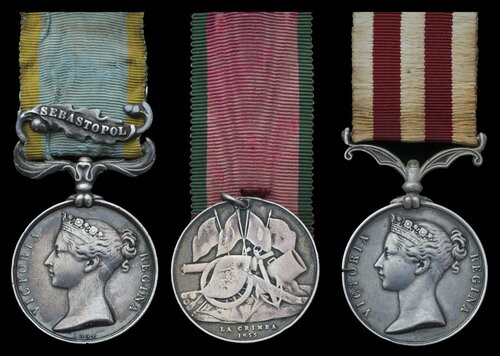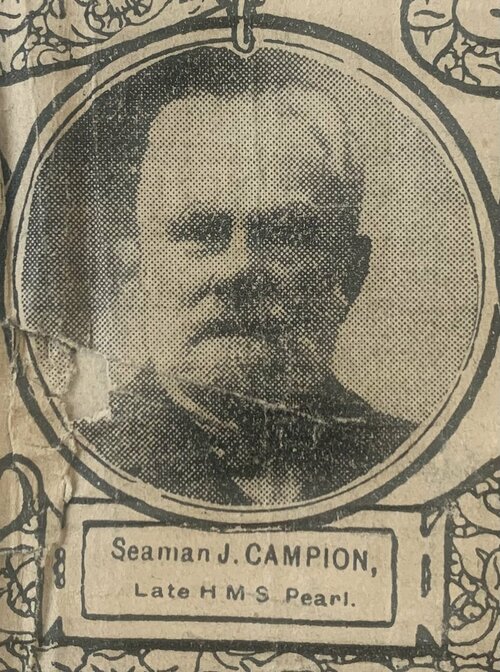Auction: 22001 - Orders, Decorations and Medals
Lot: 327
'One cannot pay too high a tribute to the memory of such a man, he was a credit to the Navy, loyal to his Queen, a patriot, in fact a Britisher.'
Campion's obituary, 11 September 1911.
The rare and fascinating Indian Mutiny group of three to Able Seaman J. Campion, R.N., a member of Pearl's Naval Brigade, which rendered invaluable service on the River Gogra in the darkest days of the campaign
Crimea 1854-56, 1 clasp, Sebastopol (Jas. Campion. Sailmr's Crew.), officially impressed naming; Indian Mutiny 1857-59, no clasp (Jas. Campion, A,B, Pearl.); Turkish Crimea 1855, this last brooched, very fine (3)
James Campion was born at Loughborough on 17 March 1827. A restless adventurer, he volunteered for the Franklin Expedition in 1845, along with two companions. They agreed that all were to go or none. Campion was selected, and so was another, but the third was rejected, meaning that Campion narrowly escaped death in the Northwest Passage.
Campion instead travelled to New Zealand, joining the Royal Navy at Auckland in 1848. His first ship was Calliope, 32 guns, which had played an important role in the Flagstaff War two years earlier. He then served aboard London, 92 guns, throughout the Crimean War (Medal & clasp). London took part in the bombardment of Fort Constantine, part of Sebastopol's defences, on 5 October 1854. A second-rate wooden tall ship, she sustained heavy damage from shore batteries. The Allied fleet lost 340 sailors during a six-hour gunnery duel, but made little impression on the Russian defences. Sebastopol was to defy the Allies for another eleven months.
Campion met with rather more success on his next ship, Pearl. Unlike London, Pearl was a state-of-the-art 21-gun screw-propelled corvette, launched from Woolwich in 1855. Pearl left Spithead on 30 May 1856, bound for the South Pacific. Tensions flared between Britain and Peru following the Peruvian capture of a British-flagged ship. Pearl managed to capture two Peruvian men-of-war, carrying 500 soldiers. She then sailed to the Sandwich Islands (modern-day Hawaii), before heading towards Hong Kong, where Chinese privateers were making trouble.
Along with the frigate Shannon (see previous Lot), Pearl was placed under the command of Admiral Sir Michael Seymour as the Second Opium War loomed, but in July 1857, on receiving news of the Indian Mutiny, both ships hurried towards Calcutta. While sailing through the Strait of Malacca, Pearl's crew spotted groups of redcoats along the shore. These were the 90th Foot (Perthshire Volunteers), this regiment having been wrecked off Singapore some days earlier. Pearl picked them up and landed them safely at Calcutta on 8 August; the 90th went on to win six Victoria Crosses during the Siege of Lucknow.
Mutiny service
When Captain William Peel of the Shannon formed his Naval Brigade at Calcutta in early September (see previous Lot), it initially included 175 men from the Pearl. The combined force travelled up the Ganges as far as Buxar, but there they separated. While Shannon's Naval Brigade continued on to Cawnpore and Lucknow, Pearl's Bluejackets, under the command of Captain Edward Southwell Sotheby, were to play a unique role in suppressing mutinous parts of northern India. The exploits of Pearl's Naval Brigade are vividly recorded in The Cruise of the Pearl (1859), a memoir written by the Reverend E. A. Williams, who was Chaplain of the Pearl throughout her adventures.
Buxar was one of the main government studs for breeding cavalry horses, and Pearl's Naval Brigade was used as a garrison at its nearby fort. There the Bluejackets were drilled daily, becoming proficient in the movement of heavy guns. On 23 October, news was received of a mutiny at Chupra, about forty miles north of Buxar on the border with Nepal. This mutiny threatened to engulf several districts north of the Ganges, yet Pearl's Naval Brigade was the only European force within 200 miles of the area. Sotheby's small command had recently been reinforced by a company of 80 men sent up from Calcutta, under the command of Lieutenant Radcliffe. A few of these men were volunteer merchants, but the vast majority belonged to Pearl's crew. This brought the total strength of Pearl's Naval Brigade to 250 officers and men. Its armament was four 12-pounder howitzers.
On Christmas Day, the Naval Brigade was reinforced by the Gorruknath and Ramdhul Gurkha Regiments, together numbering some 850 men. Named the Sarun Field Force, the whole was placed under the command of Colonel Rowcroft, a Company officer whose own regiment, the 8th Bengal Native Infantry, had mutinied at Dinapoor. In late December, the force engaged 6,000 mutineers with 9 guns led by Naib Nazim Mushuruff Khan at the village of Sohunpore. The four howitzers held the centre of the line, protected on either side by Gurkhas. Lieutenant Turnor, R.N., directed the howitzers with great precision and silenced two enemy guns in a matter of minutes. The enemy fled towards Goruckpore. Williams recalled that without suffering a single casualty, the Naval Brigade:
'...pursued the enemy with a rapidity and perseverance not to be outstripped, the 12-pounder howitzers discharged shot and shell on their retreating and broken ranks with a precision and effect not to be surpassed, eliciting the praise from the commanding officer that the "troops behaved as British seamen and marines ever do, most excellently and gallantly."'
Whereas the Shannon's Naval Brigade used bullocks to haul guns in the flat plains of Oudh, horses were more suitable in the foothills of the Himalayas. Sotheby had to train his sailors to 'break in' locally-sourced draught horses. All the harnesses, saddlery and traces had to be improvised. On 8 February 1858, 150 small boats were procured, and the force proceeded up the River Gogra. Fascines were strapped to the boats' sides to offer protection from snipers on the banks. After taking Chanderpore, the force confronted Jung Bahadoor's 8,000 rebels at Gai Ghat. The Naval Brigade provided covering fire while the Gurkhas charged the enemy with their kukris, driving them back to the vicinity of Fyzabad.
These operations became known as the 'Trans-Gogra Campaign', since the force had to suppress mutinous sepoys on both sides of that river. On 2 March it reached Amorah, 12 miles from Fyzabad. Several days later, and having been reinforced by 200 men of the Bengal Yeomanry Cavalry, the force attacked rebel entrenchments at Belwa. The Naval Brigade's howitzers lobbed shells into the enemy positions, causing horrific casualties. Returning to its encampment at Amorah, the force was itself attacked on 5 March by around 5,000 mutineers led by the Rajahs of Gonda and Churdah. These sepoys were from the Gwalior Contingent, and had been well trained in European tactics. Despite such overwhelming odds, Williams wrote that the Naval Brigade:
'...continued advancing on the multitudes in front, and never halted to draw breath except when they came within easy range for a discharge of grape. Then they unlimbered the guns, fired as many rounds as the retreating multitude would wait to receive; then limbering up, would gallop the guns more like horse than foot artillery, and when within range, would again unlimber and discharge as many rounds as the time admitted.'
The Bluejackets' transformation from sailors into horse artillerymen was an extraordinary feat, for which Captain Sotheby received no fewer than 13 mentions in dispatches (e.g. London Gazette, 23 April 1858). The Trans-Gogra Campaign involved 28 separate actions, which cannot all be detailed here. Suffice to say that without Rowcroft's force holding them down, as many as 30,000 sepoys might have been available to confront Sir Colin Campbell at Lucknow.
Journey's end
Campion retired in 1860 after twelve years' service, and his Mutiny Medal was sent to him on 24 April 1861. He was awarded a pension of £9 2s 0d per annum. Many of his friends in the Nottingham Crimean & Indian Mutiny Veterans' Association felt this sum was derisory. They argued that, 'had he approached the Admiralty with a tale of poverty… in all probability he would have been treated with compassion instead of contempt.'
Towards the end of his eventful life, Campion suffered from throat cancer. In his last days he lived with his nephew, Mr Squires, at 414 Berridge Road, Nottingham. Following his death on 10 September 1911, a heartfelt obituary appeared in the journal of the Nottingham Crimean & Indian Mutiny Veterans' Association, containing this sad account of Campion's illness:
'This old seaman was one of the type of men fast dying out, independent, industrious, fearless, honourable. When the secretary visited him, unaware of the terrible complaint he was suffering from (cancer in the throat), Campion remarked: "Mr Whitby, I have not tasted any solid food for over eleven weeks. I don't seem to be able to swallow, and unless they discover a new road to feed people I am afraid my time is not long. Never mind I've had a good innings… remember me to all my comrades."'
Full military honours were accorded Campion at his funeral in the Church Cemetery, Mansfield Road, Nottingham; sold together with his original obituary notice.
Subject to 20% VAT on Buyer’s Premium. For more information please view Terms and Conditions for Buyers.
Sold for
£1,500
Starting price
£1200







